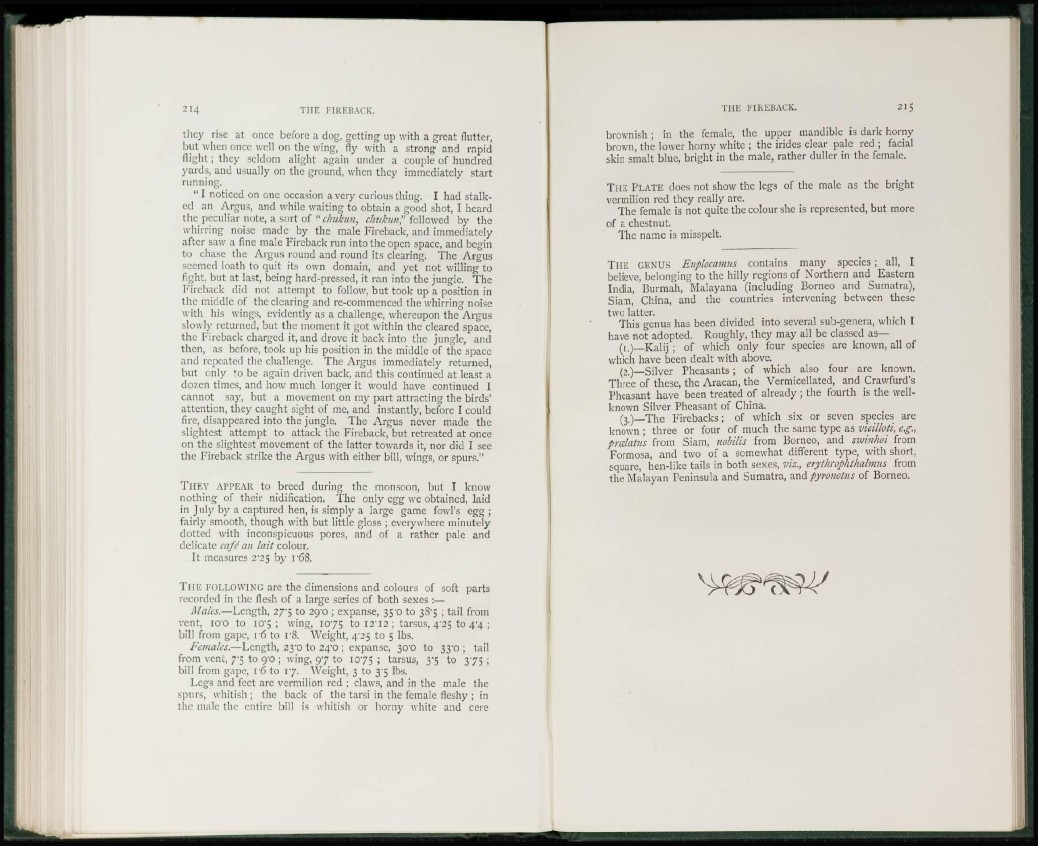
214 THE FIREBACK.
tlicy rise at once before a dog, getting up with a great flutter,
but when once well on the wing, fly with a strong and rapid
flight; they seldom alight again under a couple of hundred
yards, and usually on the ground, when they immediately start
running.
" I noticed on one occasion a very curious thing. I had stalked
an Argus, and while waiting to obtain a good shot, I heard
the peculiar note, a sort of "chukun, chukun" followed by the
whirring noise made by the male Fireback, and immediately
after saw a fine male Fireback run into the open space, and begin
to chase the Argus round and round its clearing. The Argus
seemed loath to quit its own domain, and yet not willing to
f.ght, but at last, being hard-pressed, it ran into the jungle. The
Fireback did not attempt to follow, but took up a position in
the middle of the clearing and re-commenced the whirring noise
with his wings, evidently as a challenge, whereupon the Argus
slowly returned, but the moment it got within the cleared space,
the fireback charged it, and drove it back into the jungle, and
then, as before, took up his position in the middle of the space
and repeated the challenge. The Argus immediately returned,
but only to be again driven back, and this continued at least a
dozen times, and how much longer it would have continued I
cannot say, but a movement on my part attracting the birds'
attention, they caught sight of me, and instantly, before I could
fire, disappeared into the jungle. The Argus never made the
slightest attempt to attack the Fireback, but retreated at once
on the slightest movement of the latter towards it, nor did I see
the Fireback strike the Argus with cither bill, wings, or spurs."
TFIEY APPEAR to breed during the monsoon, but I know
nothing of their nidification. The only egg we obtained, laid
in July by a captured hen, is simply a large game fowl's egg ;
fairly smooth, though with but little gloss ; everywhere minutely
dotted with inconspicuous pores, and of a rather pale and
delicate cafe* au lait colour.
It measures 2^25 by r68.
T H E FOLLOWING are the dimensions and colours of soft parts
recorded in the flesh of a large series of both sexes :—
Males.—Length, 27'5 to 20/0 ; expanse, 35'0 to 38'5 ; tail from
vent, io'O to I0'5 ; wing, 1075 to I 2 T 2 ; tarsus, 4^25 to 4'4 ;
bill from gape, 16 to i'8. Weight, 4'25 to 5 lbs.
Females.—Length, 23T) to 24'0 ; expanse, 30'0 to 33'0 ; tail
from vent, 7'5 to 0/0 ; wing, 97 to 1075 ; tarsus, 3*5 to 375 ;
bill from gape, v6 to 17. Weight, 3 to 3-5 lbs.
Legs and feet arc vermilion red ; claws, and in the male the
spurs, whitish ; the back of the tarsi in the female fleshy ; in
the male the entire bill is whitish or horny white and cere
THE FIREBACK. 215
brownish ; in the female, the upper mandible is dark horny
brown, the lower horny white ; the hides clear pale red ; facial
skin smalt blue, bright in the male, rather duller in the female.
T H E PLATE does not show the legs of the male as the bright
vermilion red they really are.
The female is not quite the colour she is represented, but more
of a chestnut.
The name is misspelt.
T H E GENUS Eitplocamus contains many species ; all, I
believe, belonging to the hilly regions of Northern and Eastern
India, Burmah, Malayana (including Borneo and Sumatra),
Siam, China, and the countries intervening between these
two latter.
This genus has been divided into several sub-genera, which I
have not adopted. Roughly, they may all be classed as—
(1.)—Kalij ; of which only four species are known, all of
which have been dealt with above.
(2.)—Silver Pheasants ; of which also four are known.
Three of these, the Aracan, the Vermicellated, and Crawfurd's
Pheasant have been treated of already ; the fourth is the wellknown
Silver Pheasant of China.
(3.)—The Fircbacks; of which six or seven species are
known ; three or four of much the same type as vieilloti, e.g.,
prcslatus from Siam, nobilis from Borneo, and swinhoi from
Formosa, and two of a somewhat different type, with short,
square, hen-like tails in both sexes, viz., erythrophtlialmus from
the Malayan Peninsula and Sumatra, and pyronotits of Borneo.